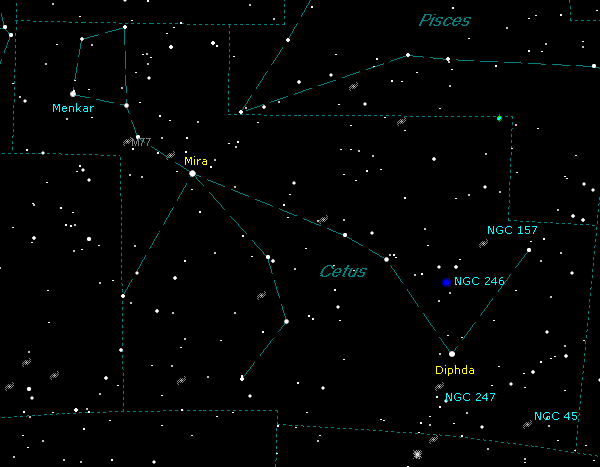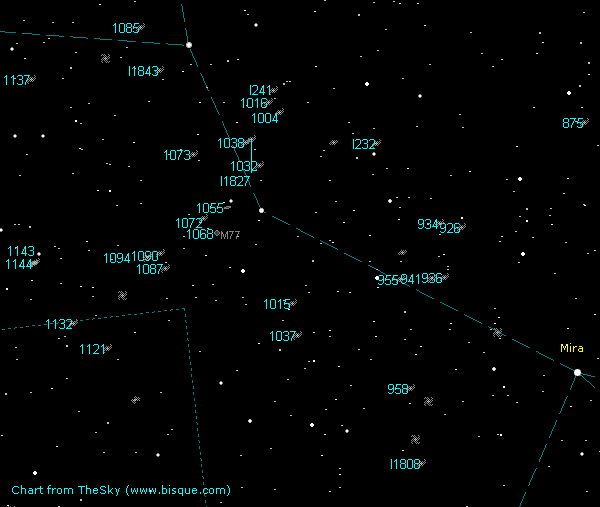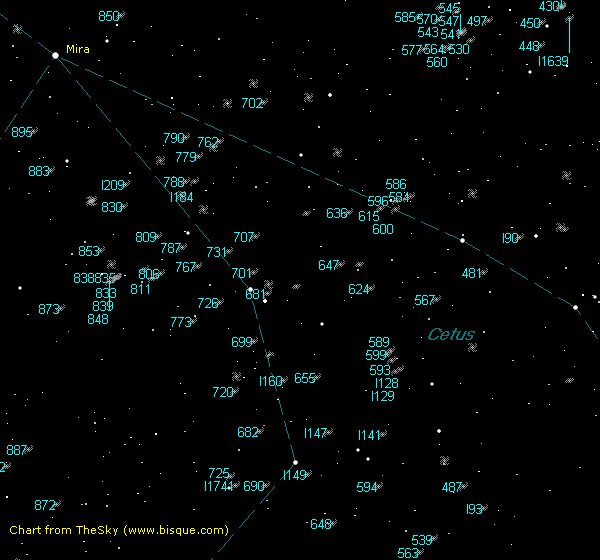Long Cold Nights
Here we are – the last month of 2012. If you do not have a blanket of snow on the ground where you live, it is only a matter of time until it arrives. But before that happens, let’s do some late autumn observing. Cetus the Whale is the fourth largest constellation in the night sky. Within its, 1,231 square degrees lie more than 50 NGC objects down to magnitude 12.0 with that number tripling when you go down to 13th magnitude.
Cetus plays a role in the mythological story of the Royal Family of Constellations. Mira is the second variable star ever observed but first pulsating one. In fact, when first discovered in 1596, Mira was thought to be a nova but with a period 332 days and a range in brightness from 2.0 to 10.1, Mira came back to its original brightness.
At a distance of 400 light-years the Hubble Space Telescope was able to imagine this red giant and as you can see is not perfectly round. Adding to the mystery is the extended feature to the left of the star. This comet-like tail (seen in the ultraviolet) could be as long as 13 light-years, consisting of material ejected from Mira itself. This parent star has a smaller companion located 0.1 arc seconds away. Mira B appears to lie some seventy astronomical units and orbits once in 400 years. This star is also a variable ranging from magnitude 9.5 to 12.0 as is also referred to as VZ Ceti.
Now on to some choice objects such as NGC 246 aka the Skull Nebula. Located an estimated 1,600 light-years from Earth, this planetary nebula is not like others of its kind, this one is on the move - literally. Plowing through space at 50 kilometres per second, the Skull’s outer shell is clashing with the interstellar medium and forms a brighter arc at the top of the photo. This impact arc is generating heat in the order of 200,000 degrees Kelvin. The bottom is the trailing portion. NGC 246 is now in its later stages of life, a process that has been occurring for the past 1,000 years. To locate the Skull, simply move your scope a bit more than six degrees directly north of the star Diphda. Before leaving the Skull, check out NGC 255 to the north. In fact, both would fit nicely in a wide-angle eyepiece. This face-on barred spiral is 65 million light-years hovers around the twelfth magnitude range.

From the Skull, move four and a half degrees north-west to another galaxy NGC 157. This lovely ‘S’ shaped spiral lies 65 million light-years and shines at magnitude 10.4. Its overall measurement in arc minutes is 3.5 X 2.4. Another well-defined galaxy is NGC 908. Dubbed the Starburst Galaxy, many young stars are developing from numerous clouds seen in the galaxy’s arms. It was discovered by William Herschel in 1786. The tail-like appearance is probably the result of a close passing more massive galaxy yanking on it and pulling out of place.
Now turn back to the star Mira and then continue almost three degrees to the northeast till you come across another detailed spiral galaxy NGC 936. This magnitude 10.1 galaxy lays 67 million light-years away and resides with four other galaxies such as NGC 926 and 934 to the north as well as NGC 955 and 941 to the east of it.

Of all the galaxies found within the confines of Cetus, we save the brightest for last. M77 is a somewhat face-on spiral galaxy the Charles Messier described it in his famous catalogue as a cluster of stars with nebulosity. M77 is an active Seyfert Galaxy estimated at 60 million light-years away and is considered one of the largest galaxies out there. Its size is thought to be a staggering 170,000 light-years across and has a population of a trillion stars or five times that of the Milky Way.
The annual Messier Marathon held within the third week of March of any year is that special time when the Sun and its glare do not hide any of the 110 Messier objects. A particular order of locating the objects visually starting in the west after twilight and ending in the east before twilight is a must. Sometimes you are battling a lightening sky while trying to visually hunt for the few last targets. M77 is second on the search list and could be a challenge while fighting the dwindling twilight before losing it below the western horizon.

This should be an excellent year for the Geminid meteor shower. Plan your calendar for the night of December 13th as the moon will be absent from the sky. If you can last all night, you will be rewarded with seeing very slow and graceful meteors burning up at 36 kilometres per second. The annual rate of this shower is 120 meteors per hrs. So dress warm and enjoy the best celestial shows of the year.
Now that Jupiter has attained opposition on the 3rd, the king of the planets rises in the east as the sun sets in the west. With our two worlds at its closest, nights of low turbulence with reward you with some fantastic sights and chances to image this gas giant. As always, consult the RASC 2013 Observer’s Handbook page 243 for times of transits and shadows of its four main Galilean moons. With the New Moon occurring on the 13th at 3:42 EST coupled with the Moon’s closest distance (perigee) from us at 357,075 km some four hours earlier will yield the highest tides. The Full Cold Moon or the Long Night Moon occurs on the 28th at 5:21 EST.
And lastly – it is that time of year we look to purchasing a telescope for that budding beginner. Make sure you stay away from making a purchase from those big box stores. They usually stock the very inexpensive and cheaply made telescopes. Be sure to search the Internet for a true telescope store close to you. These stores or on-line ordering are tailored for astronomy and you can trust their advice.
Well, that is it for another year. As we look forward to 2013 for many great observing sessions and special events especially Comet Panstarrs and 2012/S1 in December. I would like to wish you and you’re a very Merry Christmas and a Happy and Healthy New Year.
Clear skies everyone.
